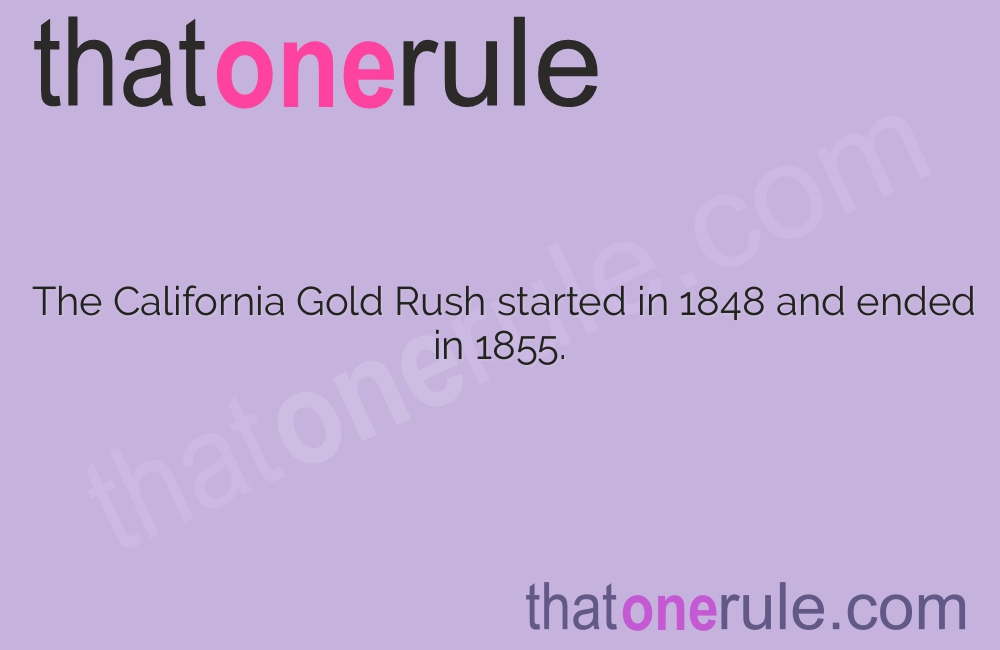Gold Rush – 10 Fascinating Facts About the Legendary Gold Rushes

The California Gold Rush started in 1848 and ended in 1855.
Gold was discovered at Sutter’s Mill in Coloma, California.
The discovery of gold in California brought around 300,000 people to the state.
The phrase Gold rush originates from the rush of people hoping to find gold.
Many people traveled to California by sailing around Cape Horn, the southern tip of South America.
During the Gold Rush, San Francisco’s population grew from 1,000 to over 20,000 in just two years.
It is estimated that around $2 billion worth of gold was extracted during the California Gold Rush.
The Gold Rush had a significant impact on California’s economy, transforming it from a territory to a state.
The Gold Rush attracted people from all over the world, including Australia, China, and Europe.
Miners who illegally rushed onto another person’s claimed land were called claim jumpers.
Levi Strauss established a successful business selling tough denim pants to miners during the Gold Rush.
Gold mining techniques during the Gold Rush ranged from simple panning to complex hydraulic mining.
The majority of the gold extracted during the Gold Rush came from placer deposits.
Women played various roles during the Gold Rush, including miners, merchants, and prostitutes.
The Sierra Nevada, located in California, was one of the richest gold-bearing regions during the Gold Rush.
The effects of the Gold Rush included environmental degradation and the displacement of Native American tribes.
Gold Rush – 10 Fascinating Facts About the Legendary Gold Rushes part 2
Some prospectors became wealthy during the Gold Rush, while others struggled to find any significant gold.
The Gold Rush lured people with dreams of instant wealth, but many ended up disappointed.
The term forty-niners refers to the gold seekers who migrated to California in 1849.
The Gold Rush led to an increase in lawlessness, prompting the formation of vigilante groups.
People flocked to gold-mining towns, creating a boom in the construction of infrastructure and businesses.
The population of California increased by over 300% during the Gold Rush.
The Gold Rush had a significant impact on the native population, leading to violence and disease.
John Augustus Sutter, the owner of Sutter’s Mill, saw his property overrun by gold seekers.
The Gold Rush inspired numerous songs, poems, and stories reflecting the struggles and dreams of miners.
Many miners scrambled to stake their claims legally, resulting in elaborate and often disputed land regulations.
Chinese miners played a crucial role in the California Gold Rush, facing significant discrimination.
Gold rush towns often sprang up overnight, with hastily built structures to accommodate the influx of people.
Some gold towns turned into long-lasting settlements, while others faded away once the gold was depleted.
The Gold Rush had a profound impact on the indigenous peoples of California, leading to the loss of their lands and way of life.
Gold rush prospectors faced numerous hardships, including extreme weather, disease, and banditry.
The Gold Rush led to the establishment of mining-related industries, such as pick and shovel manufacturing.
Many settlers abandoned their previous professions to become prospectors during the Gold Rush.
The Gold Rush sparked technological advancements in mining equipment and techniques.
Not all people who succeeded during the Gold Rush were miners – some made their fortunes as merchants or entrepreneurs.
The Gold Rush created a temporary economic boom but also left behind a legacy of social and environmental challenges.
The California Gold Rush inspired similar rushes in other parts of the world, such as Australia and South Africa.
James W. Marshall, a carpenter working for John Sutter, discovered gold at Sutter’s Mill.
The Gold Rush had a significant impact on the culture and folklore of California, shaping its identity.
The Gold Rush attracted people from all walks of life, including doctors, lawyers, and adventurers.
The scarcity of law enforcement during the Gold Rush created a sense of lawlessness and disorder in some areas.
The Gold Rush led to the establishment of banking and financial institutions to handle the influx of wealth.
Many gold rush prospectors left their families behind, hoping to strike it rich and return to them with newfound wealth.
The Gold Rush brought people from diverse backgrounds together, fostering cultural exchange and conflict.
The legacy of the Gold Rush is still visible in California today, with preserved sites and museums dedicated to its history.

